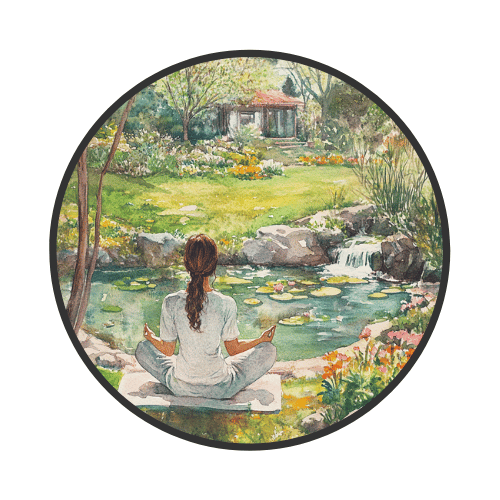Meditation is a time-honored practice with a history covering multiple cultures and millennia. Initially seen in ancient India's religious and philosophical traditions, the discipline has evolved from ancient scriptures to modern practice, adapting to meet various societies' and people's spiritual, psychological, and health-related needs.
The earliest records of meditation are found in the Vedas, ancient sacred texts of India, around 1500 BCE. These texts describe various meditative techniques that formed the foundation of later Hindu spiritual practices. Meditation was a path to spiritual enlightenment and a method for deeper self-realization and understanding of the cosmos.
Buddhism, founded by Siddhartha Gautama in the 6th century BCE, further developed and explored meditation, particularly mindfulness and concentrative practices. These techniques aim to provide a clear, calm, and focused mind and achieve Nirvana—the state of true liberation from human suffering and the cycle of rebirth. As Buddhism spread across Asia, it carried these meditative practices to China, Japan, and Southeast Asia, each region adapting and evolving these techniques according to local traditions and beliefs.
By the Middle Ages, meditation had permeated other major religions such as Christianity, Judaism, and Islam, each incorporating some form of contemplative practice. In the Sufi tradition of Islam, for example, meditation involves repeating sacred names. At the same time, Christian monastic orders practiced prayer that closely resembled meditation, focusing on divine presence and internal reflection.
The 20th century saw the practice of meditation move West. Pioneers like Swami Vivekananda and later Maharishi Mahesh Yogi introduced and popularized meditation in Europe and America. By the late 20th century, meditation had become part of the secular mindfulness movement, largely thanks to Jon Kabat-Zinn, who founded the Mindfulness-Based Stress Reduction (MBSR) program in 1979. This program highlighted the health benefits of meditation, free from its religious ties, making it accessible to a broader audience.
Modern science has taken an interest in meditation, studying its effects on the brain and body. Research by neuroscientists has shown that regular meditation can significantly alter the brain's structure and function, developing areas related to attention, emotional regulation, and mental flexibility. These changes not only reduce stress but also protect overall well-being.
Today, there are several types of popular meditation practiced around the world, including:
- Zen Meditation (Zazen) - Originating from Japan, this method involves observing the breath and posture and clearing the mind of specific thoughts.
- Yoga Meditation - Since ancient India, yoga has included various mind-body practices where meditation is integrated with physical postures and breath control.
- Loving-kindness Meditation (Metta) - Another Buddhist tradition that focuses on developing feelings of goodwill, kindness, and warmth towards others.
- Mindfulness Meditation - Rooted in the Buddhist tradition, this involves paying attention to thoughts as they pass through the mind without judgment.
- Transcendental Meditation - This involves chanting a mantra to achieve a state of relaxed awareness.
- Guided Meditation - Here, one meditates following the guidance of a teacher or a recording.
- Focused Meditation - Involves focusing on something intently to stay in the present moment.
If you are curious about the art and practice of mediation, here are some tips to help you get started:
- Start Small: Begin with short periods, like 5-10 minutes, and gradually increase the time.
- Consistent Routine: Try to meditate at the same time daily to establish it as a habit.
- Quiet Space: Find a quiet place where you won't be disturbed to help you focus.
- Comfortable Position: Sit in a comfortable position, either on a chair or cross-legged on the floor.
- Breathing: Pay attention to your breath to help anchor your mind and reduce wandering thoughts. Check out Keyan’s article on breathwork here!
- Incorporate Variety: Experiment with different forms of meditation to see what suits you best. Variety can keep your practice fresh and engaging.
- Use Technology: Apps and online platforms can provide guided sessions and help track your progress. Headspace, Calm, Insight Timer, and 10% Happier are good ones to try.
- Join a Community: Participating in a group can help your motivation and provide support.
A Simple Mantra to try at home
A mantra can be a sound, word, or phrase repeated to aid concentration in meditation. One of the simplest and most universally used mantras is Om. It is a sacred sound in Hinduism and Buddhism, symbolizing the essence of the universe.
- Sit comfortably and close your eyes.
- Take a few deep breaths to relax your body.
- Begin to repeat Om silently in your mind or hum it softly, timing it to the length of your breath.
- With each repetition, feel your body and mind more relaxed and centered.
- Continue for the duration of your meditation session.
Meditation is beautifully simple and quickly adapts to anyone who embraces the practice. So the next time you're craving peace, why not give meditation a go? It's the very heart of tranquility.









Leave a comment
All comments are moderated before being published.
This site is protected by hCaptcha and the hCaptcha Privacy Policy and Terms of Service apply.